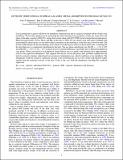| dc.contributor.author | Bregman, Joel N. | |
| dc.contributor.author | Seitzer, Patrick | |
| dc.contributor.author | Cowley, C. R. | |
| dc.contributor.author | Miller, Matthew J. | |
| dc.contributor.author | Miller, Eric D | |
| dc.date.accessioned | 2015-02-18T14:26:22Z | |
| dc.date.available | 2015-02-18T14:26:22Z | |
| dc.date.issued | 2013-03 | |
| dc.date.submitted | 2010-07 | |
| dc.identifier.issn | 0004-637X | |
| dc.identifier.issn | 1538-4357 | |
| dc.identifier.uri | http://hdl.handle.net/1721.1/94577 | |
| dc.description.abstract | Gas accreting onto a galaxy will be of low metallicity while halo gas due to a galactic fountain will be of near-solar metallicity. We test these predictions by measuring the metal absorption line properties of halo gas 5 kpc above the plane of the edge-on galaxy NGC 891, using observations taken with HST/STIS toward a bright background quasar. Metal absorption lines of Fe II, Mg II, and Mg I in the halo of NGC 891 are clearly seen, and when combined with recent deep H I observations, we are able to place constraints on the metallicity of the halo gas for the first time. The H I line width defines the line broadening, from which we model opacity effects in these metal lines, assuming that the absorbing gas is continuously distributed in the halo. The gas-phase metallicities are [Fe/H] = –1.18 ± 0.07 and [Mg/H] = –0.23 + 0.36/ – 0.27 (statistical errors) and this difference is probably due to differential depletion onto grains. When corrected for such depletion using Galactic gas as a guide, both elements have approximately solar or even supersolar abundances. This suggests that the gas is from the galaxy disk, probably expelled into the halo by a galactic fountain, rather than from accretion of intergalactic gas, which would have a low metallicity. The abundances would be raised by significant amounts if the absorbing gas lies in a few clouds with thermal widths smaller than the rotational velocity of the halo. If this is the case, both the abundances and [Mg/Fe] would be supersolar. | en_US |
| dc.description.sponsorship | United States. National Aeronautics and Space Administration (Hubble Space Telescope Grant) | en_US |
| dc.description.sponsorship | United States. National Aeronautics and Space Administration (Long Term Space Astrophysics Grant) | en_US |
| dc.description.sponsorship | United States. National Aeronautics and Space Administration (Astrophysics Data Analysis Program Grant) | en_US |
| dc.language.iso | en_US | |
| dc.publisher | IOP Publishing | en_US |
| dc.relation.isversionof | http://dx.doi.org/10.1088/0004-637x/766/1/57 | en_US |
| dc.rights | Article is made available in accordance with the publisher's policy and may be subject to US copyright law. Please refer to the publisher's site for terms of use. | en_US |
| dc.source | American Astronomical Society | en_US |
| dc.title | OUTFLOW VERSUS INFALL IN SPIRAL GALAXIES: METAL ABSORPTION IN THE HALO OF NGC 891 | en_US |
| dc.type | Article | en_US |
| dc.identifier.citation | Bregman, Joel N., Eric D. Miller, Patrick Seitzer, C. R. Cowley, and Matthew J. Miller. “OUTFLOW VERSUS INFALL IN SPIRAL GALAXIES: METAL ABSORPTION IN THE HALO OF NGC 891.” The Astrophysical Journal 766, no. 1 (March 7, 2013): 57. © 2013 The American Astronomical Society | en_US |
| dc.contributor.department | MIT Kavli Institute for Astrophysics and Space Research | en_US |
| dc.contributor.mitauthor | Miller, Eric D. | en_US |
| dc.relation.journal | The Astrophysical Journal | en_US |
| dc.eprint.version | Final published version | en_US |
| dc.type.uri | http://purl.org/eprint/type/JournalArticle | en_US |
| eprint.status | http://purl.org/eprint/status/PeerReviewed | en_US |
| dspace.orderedauthors | Bregman, Joel N.; Miller, Eric D.; Seitzer, Patrick; Cowley, C. R.; Miller, Matthew J. | en_US |
| mit.license | PUBLISHER_POLICY | en_US |
| mit.metadata.status | Complete | |
